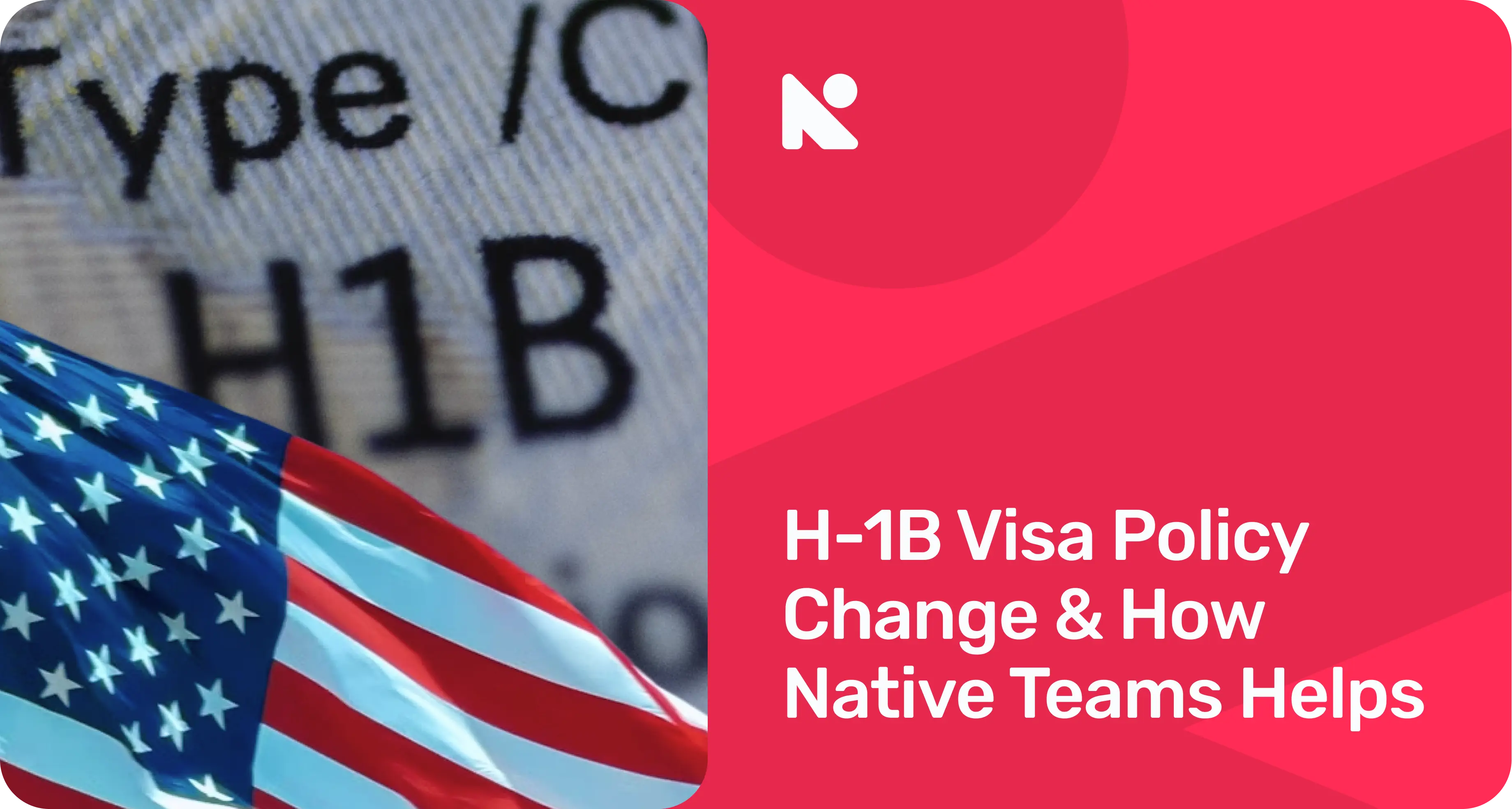H-1B Visa Changes in 2025: What U.S. Companies Need to Know and the Best Alternatives
In 2025, the U.S. government rolled out a dramatic update to its immigration policy: a $100,000 fee for every new H-1B visa application. For decades, the H-1B programme allowed American companies to bring in highly skilled international workers. Now, that once-reliable route comes with a price tag that can wipe out a hiring budget in a single stroke.
If you’re an HR leader, startup founder or talent acquisition manager, this isn’t just another bureaucratic change. It forces you to rethink how your organisation accesses global expertise. Do you absorb the cost, scale back your hiring plans, or explore U.S. global hiring alternatives that don’t require a visa at all?
In this article, we break down the H-1B visa changes 2025 in plain language, show what they mean for businesses of all sizes, and outline how remote hiring and Employer of Record solutions like Native Teams make it simple to hire talent abroad without visa headaches while staying on top of remote hiring compliance.

What are the new H-1B visa changes for 2025?
- Previous costs: Sponsoring an H-1B worker already involved several thousand dollars in legal and filing fees, plus months of paperwork.
- New fee: An additional $100,000 per application dramatically increases the total cost.
- Who pays and the impact: The employer, not the employee. This means the burden falls directly on U.S. companies. The total cost per sponsored employee can now exceed six figures, even before relocation expenses.
For a single hire, $100,000 may already be unsustainable. For a company sponsoring multiple employees each year, the numbers quickly run into millions.
This increase puts H-1B sponsorship out of reach for many startups and mid-sized businesses. Even large enterprises must think carefully about the return on such a major investment.
The problem: Why this matters for businesses
For startups, growing companies, and even large enterprises, the new $100,000 H-1B visa fee presents a major problem. Here are some of these problems:
Financial pressure on startups and SMBs
For early-stage startups, a single H-1B visa now costs more than many employees' entire yearly salary. Hiring just a few key international experts could now cost a company hundreds of thousands of dollars, making it financially unviable. This effectively turns the H-1B visa into a "luxury permit" that only the largest corporations can afford.
Reduced access to global skills
The H-1B program was designed to help companies fill skill gaps and bring in top-tier global expertise. With the new fee, the talent pool shrinks dramatically. Companies will be forced to miss out on brilliant engineers, designers, and innovators from around the world simply because they can't afford the visa cost. This hurts not only individual businesses but also the U.S. economy's ability to innovate and compete on a global scale.
More paperwork and legal exposure
Beyond the cost, the traditional H-1B process already demands detailed applications, strict timelines, and compliance checks that require significant time and legal resources to manage. For many HR leaders and talent managers, the process is already a major headache. The new fee only adds to the pressure, forcing companies to question whether the traditional visa-based model is worth the effort anymore.

The shift towards remote hiring and outsourcing
In response to this change, we are seeing a major shift in how U.S. companies approach international hiring. Instead of trying to bring talent physically onshore, businesses are now accelerating their move toward remote-first and outsourcing models.
Why the sudden change? Because these models offer a clear and affordable way to access the same global talent pool without any of the visa headaches.
- Cost-effectiveness: Hiring remotely is significantly cheaper. You can access top talent in countries with lower costs of living, saving money on salaries, office space, and, most importantly, expensive visa fees.
- Faster scaling: Without the long, unpredictable visa process, you can hire the right person as soon as you find them. This allows your team to scale faster and respond to market needs more quickly.
- Wider talent pool: Remote work breaks down geographical barriers. You can hire an incredible developer in Brazil, a marketing expert in the UK, or a designer in the Philippines. This gives you access to a massive and diverse pool of candidates that was previously out of reach.
This is where the Employer of Record (EOR) model comes in. It's a simple, legal, and compliant solution that lets you hire in other countries without needing to set up your own local business entity.
Related topic: 7 Crucial Benefits of Remote Work for Employers in 2025
How Native Teams can be the perfect alternative to the H-1B route
Native Teams enables U.S. companies to hire, pay, and manage people in 85+ countries without visas or local legal entities. Instead of spending six figures per person to relocate staff, you can work with professionals where they already live, while we handle every legal and administrative detail for you.
Here’s how our Employer of Record solution makes it possible to hire talent abroad without visa costs and still stay on top of remote hiring compliance:
- Presence in 85+ countries: We already have legal entities and infrastructure in over 85 countries. This means you can start hiring immediately using our local entities.
- Payroll and benefits management: Native Teams processes on-time salaries, tax withholdings, social contributions and benefits packages in line with each country’s regulations — boosting trust and retention.
- Compliant contracts: Every employment or contractor agreement we issue is tailored to local law. This protects you from misclassification risks and reassures your workers that their rights are protected.
- No visa costs: Because your employees remain in their home countries, there’s no need for H-1B sponsorship, immigration lawyers, or relocation budgets.
- Transparent pricing: Whether you need one specialist or a whole team, our plans scale with you. You’ll know upfront what each hire costs and can budget accordingly.
Quick checklist for HR leaders and founders
Before you adjust your hiring strategy, run through this quick guide. It highlights the key actions U.S. companies should take after the H-1B visa changes in 2025.
- Understand the H-1B visa changes for 2025 and their budget impact.
- Identify roles that can be done remotely.
- Explore U.S. global hiring alternatives like EOR solutions.
- Review your current contracts for remote hiring compliance.
- Partner with Native Teams to hire talent abroad without visa hassles.
Conclusion and your next step
The new $100,000 H-1B visa fee is a serious roadblock for most U.S. businesses, but it doesn’t have to cut off your access to global talent. Instead, it’s a signal to rethink hiring.
The future of global hiring isn’t about relocating people; it’s about building strong, distributed, remote-first teams. With Native Teams, you can hire international experts without visas, without setting up local entities, and without blowing your budget.
Ready to keep hiring globally without the $100,000 visa fee?
